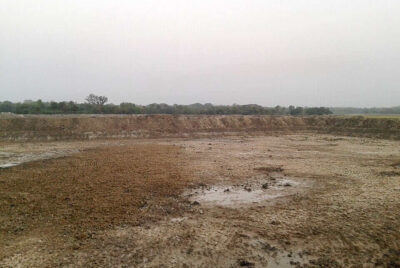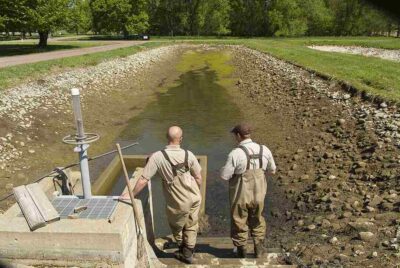What is a Detention Pond?
In a world increasingly grappling with urbanization and unpredictable weather patterns, understanding what is a detention pond has become more crucial than ever. Often mistaken for its counterpart – the retention pond – this engineered marvel plays a critical role in managing stormwater and preventing flooding. Let’s dive into the world of detention ponds and explore their importance, design, utilization, and maintenance.
Understanding Detention Ponds: An Overview
A detention pond, also known as a “detention basin,” serves as a temporary storage facility for stormwater runoff. Designed as a large, man-made depression, it collects excess water during heavy rains, holding it temporarily and then releasing it gradually to avoid downstream flooding. Contrasting with a retention pond, a detention pond is typically dry and only fills with water during rain events.
Detention Ponds Vs. Retention Ponds
Though often used interchangeably, detention and retention ponds have distinct characteristics and functions.
Detention Ponds
Detention ponds, essentially, are dry basins that temporarily house stormwater runoff. They are engineered to collect water during heavy rainfall and gradually release it, thereby preventing flooding and erosion.
Retention Ponds
On the other hand, retention ponds, or “wet basins,” are designed to hold water permanently. Besides storing runoff, they allow for the infiltration of water into the ground or its evaporation. Retention ponds are often used when the water table is near the surface.
The main difference between these two types of ponds lies in their functionality: detention ponds manage stormwater quantity, while retention ponds contribute to both water quantity and quality management.
The Importance of Detention Ponds – (What Is a Detention Pond)
The advent of urbanization has led to the replacement of permeable ground with impermeable surfaces like concrete, which increases the volume and speed of stormwater runoff, leading to flooding and erosion. Detention ponds bridge this gap by effectively managing stormwater runoff.
Flood Control
Detention ponds act as a buffer during heavy rain events. They collect and store excess water that would otherwise overflow into residential and commercial areas, causing significant damage.
Water Quality Improvement
While their primary function is to manage water quantity, detention ponds also contribute to water quality. As the water pools in the pond, its velocity reduces significantly, allowing suspended sediments to settle at the bottom. This process, combined with the biological activity within the pond, can help improve the water quality.
Recreational Use and Habitat Creation
Detention ponds often double as recreational spaces in urban areas. They can be designed to accommodate activities like boating and fishing. Moreover, these ponds can foster a new aquatic ecosystem, attracting diverse wildlife species.
Designing a Detention Pond – (What Is a Detention Pond)
The design of a detention pond requires careful consideration of several factors, such as land availability, the volume of runoff, and overflow management.
Land Availability – (What Is a Detention Pond)
The foremost constraint in designing a detention pond is the availability of land. The pond must be large enough to accommodate the volume of runoff generated by the rain event it is designed to handle.
Depth Considerations – (What Is a Detention Pond)
While increasing the depth of the pond may seem like a solution for increasing its volume, it’s crucial to ensure that the pond’s bottom doesn’t become anoxic or that the pond doesn’t start to thermally stratify.
Overflow Management – (What Is a Detention Pond)
A sound design should also consider managing overflow water. A possible solution could be the inclusion of a grass spillway to transport excess water away from developed areas.
The Importance of Maintaining Detention Ponds
Detention ponds play a crucial role in water management systems, especially in urban areas. These engineered structures serve to mitigate flooding risks and improve the quality of stormwater runoff by allowing sedimentation. However, the effectiveness of detention ponds relies heavily on regular maintenance. Below are some of the key considerations and steps in the maintenance of detention ponds:
Regular Inspections: – (What Is a Detention Pond)
Assess the pond structure for any signs of damage or erosion. Be especially aware of the sides and bottom of the pond.
Monitor the water level to ensure it matches the designed water fluctuation, which is crucial for flood control.
Regularly check inflow and outflow structures to guarantee they’re free of debris and working properly.
Vegetation Management: – (What Is a Detention Pond)
Vegetation is essential for water purification and soil stabilization. However, overgrown plants can obstruct water flow and reduce the pond’s capacity.
Regular trimming and mowing will keep vegetation growth under control. Aim to keep a balance between bare soil and dense growth.
The removal of invasive species should be a priority as they can hinder the growth of native plants that support local wildlife and better stormwater management.
Trash and Debris Removal:
Regularly remove trash and debris from the pond and the surrounding area. These can block inflow and outflow structures, reducing the pond’s efficiency.
Sediment Removal:
Over time, sediment and pollutants will accumulate at the bottom of the pond. This will eventually reduce the water-holding capacity of the pond and compromise water quality.
Periodically dredge the pond to maintain its effectiveness. The frequency will depend on the volume of runoff and sediment load but expect to do it every 5-10 years.
Wildlife Management:
Detention ponds often become habitats for local wildlife. While promoting biodiversity, be cautious of species that may cause damage or unbalance the ecosystem.
Avoid feeding wild animals to prevent overpopulation and dependency.
Erosion Control:
Inspect the pond’s banks and surrounding areas for signs of erosion. Eroding banks can lead to structural instability.
Employ erosion control measures such as planting suitable vegetation or installing geotextiles and erosion control blankets.
Public Safety:
Make sure safety fences and warning signs are properly installed and maintained to prevent accidents.
Access to the pond should be controlled to minimize liability and maintain the structural integrity of the pond.
Maintenance Records:
Keep track of all maintenance activities. This record will help identify recurring problems and facilitate their resolution.
Professional Assistance:
For major maintenance tasks, such as sediment removal or structural repairs, it may be necessary to hire professionals to ensure the work is done correctly and safely.
Regular maintenance of a detention pond is essential to ensure its functionality and longevity. Maintenance activities may include regular checks of water levels, removal of debris, and dredging or pumping out sediment buildup.
Detention Pond Landscaping & Design
When well-designed, a detention pond can become an aesthetic asset to a property rather than an eyesore. They can be integrated with landscape features to enhance their aesthetic appeal while also serving as an environmental strategy.
Detention and Retention Ponds in Subdivisions
Detention and retention ponds are increasingly incorporated in new suburban subdivisions for effective stormwater management. These ponds not only prevent flooding but also ward off soil erosion and filter pollutants from runoff.
Detention Basin Vs. Retention Basin
The terms ‘basin’ and ‘pond’ are often used interchangeably when referring to detention and retention facilities. Like their pond counterparts, a detention basin temporarily stores stormwater, while a retention basin holds and gradually releases water between storms. Both types of basins contribute to reducing stream erosion and controlling sedimentation pollution.
Conclusion – (What Is a Detention Pond)
In conclusion, understanding what is a detention pond and its role in stormwater management is crucial to mitigating the adverse effects of urbanization and climate change. These engineered systems are not just functional but can also serve as recreational spaces, contributing to urban biodiversity and improving community life.
Frequently Asked Questions – (What Is a Detention Pond)
Q: What is a detention pond?
A: A detention pond is a man-made depression designed to temporarily hold and gradually release stormwater runoff to prevent downstream flooding.
Q: How does a detention pond work?
A: During heavy rainfall, runoff water is directed into the detention pond. The pond holds the water temporarily and gradually releases it, preventing flooding and erosion.
Q: What is the difference between a detention pond and a retention pond?
A: A detention pond is typically dry and holds water temporarily during rain events. In contrast, a retention pond is designed to hold water permanently.
Q: What are the benefits of a detention pond?
A: Detention ponds help manage stormwater runoff, preventing flooding and erosion. They can also improve water quality and serve as recreational spaces.
Q: What are the design considerations for a detention pond?
A: The design of a detention pond should consider factors like land availability, the volume of runoff, depth of the pond, and management of overflow water.




